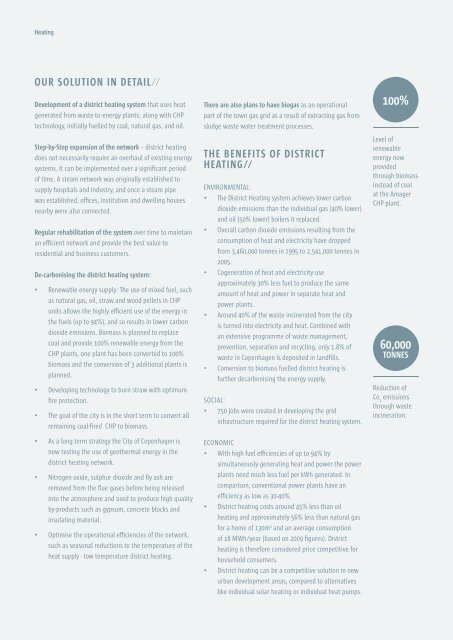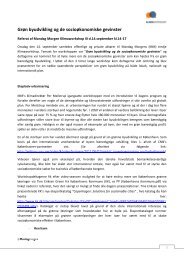Copenhagen: Solutions for Sustainable Cities - Arup
Copenhagen: Solutions for Sustainable Cities - Arup
Copenhagen: Solutions for Sustainable Cities - Arup
- No tags were found...
Create successful ePaper yourself
Turn your PDF publications into a flip-book with our unique Google optimized e-Paper software.
HeatingOur solution in detail//Development of a district heating system that uses heatgenerated from waste-to-energy plants; along with CHPtechnology, initially fuelled by coal, natural gas, and oil.Step-by-Step expansion of the network – district heatingdoes not necessarily require an overhaul of existing energysystems. It can be implemented over a significant periodof time. A steam network was originally established tosupply hospitals and industry, and once a steam pipewas established, offices, institution and dwelling housesnearby were also connected.Regular rehabilitation of the system over time to maintainan efficient network and provide the best value toresidential and business customers.De-carbonising the district heating system:• Renewable energy supply: The use of mixed fuel, suchas natural gas, oil, straw and wood pellets in CHPunits allows the highly efficient use of the energy inthe fuels (up to 94%), and so results in lower carbondioxide emissions. Biomass is planned to replacecoal and provide 100% renewable energy from theCHP plants, one plant has been converted to 100%biomass and the conversion of 3 additional plants isplanned.• Developing technology to burn straw with optimumfire protection.• The goal of the city is in the short term to convert allremaining coal-fired CHP to biomass.• As a long term strategy the City of <strong>Copenhagen</strong> isnow testing the use of geothermal energy in thedistrict heating network.• Nitrogen oxide, sulphur dioxide and fly ash areremoved from the flue gases be<strong>for</strong>e being releasedinto the atmosphere and used to produce high qualityby-products such as gypsum, concrete blocks andinsulating material.• Optimise the operational efficiencies of the network,such as seasonal reductions to the temperature of theheat supply - low temperature district heating.There are also plans to have biogas as an operationalpart of the town gas grid as a result of extracting gas fromsludge waste water treatment processes.The benefits of districtheating//Environmental:• The District Heating system achieves lower carbondioxide emissions than the individual gas (40% lower)and oil (50% lower) boilers it replaced.• Overall carbon dioxide emissions resulting from theconsumption of heat and electricity have droppedfrom 3,460,000 tonnes in 1995 to 2,541,000 tonnes in2005.• Cogeneration of heat and electricity useapproximately 30% less fuel to produce the sameamount of heat and power in separate heat andpower plants.• Around 40% of the waste incinerated from the cityis turned into electricity and heat. Combined withan extensive programme of waste management,prevention, separation and recycling, only 1.8% ofwaste in <strong>Copenhagen</strong> is deposited in landfills.• Conversion to biomass fuelled district heating isfurther decarbonising the energy supply.Social:• 750 jobs were created in developing the gridinfrastructure required <strong>for</strong> the district heating system.Economic• With high fuel efficiencies of up to 94% bysimultaneously generating heat and power the powerplants need much less fuel per kWh generated. Incomparison, conventional power plants have anefficiency as low as 30-40%.• District heating costs around 45% less than oilheating and approximately 56% less than natural gas<strong>for</strong> a home of 130m 2 and an average consumptionof 18 MWh/year (based on 2009 figures). Districtheating is there<strong>for</strong>e considered price competitive <strong>for</strong>household consumers.• District heating can be a competitive solution in newurban development areas, compared to alternativeslike individual solar heating or individual heat pumps.100%Level ofrenewableenergy nowprovidedthrough biomassinstead of coalat the AmagerCHP plant.60,000to n n e sReduction ofCo 2emissionsthrough wasteincineration.










